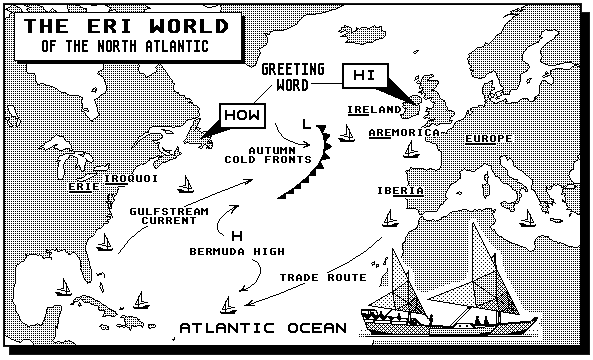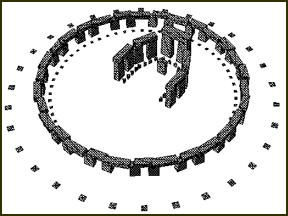spiritofatlantis.com | Duane K. McCullough

The native inhabitants of "America" are related to the Armorican maritime culture of the North
Atlantic and other seafaring tribes of Europe - moreover, according to Plato, the Atlantic Ocean was once navigable long
ago - before the "great deluge from heaven".
V2
Chapter 3: The Erie Connection
1/ Exactly when the vigesimal alphabet of Ogam was forwarded
to the British Isles from America by ancient Atlantean sailors is
not known, but it is believed that the builders of Stonehenge - the most famous and distinctive
historical monument in northern Europe, may have employed the
alphabet since many nearby megalithic stone items of that era
have Ogamic markings carved on them.
(The Stonehenge site and its "hinged" method of stone
construction, are dated to the same Neolithic era in which the
great pyramids of Egypt were built)

Stonehenge was a time-keeping tool.
Stonehenge is perhaps the most impressive megalithic structure in the northern European region that was built using iron rod and port-hole construction. Many believe it was an astronomical calendar that helped define lunar-solar time mesurements by marking the movements of the moon and sun.
2/ Furthermore, the sun-worshiping Atlantean culture that
built Stonehenge also constructed other stone megalithic sites
throughout ancient Brittany and western Europe.
(Unique megalithic stone-works called Dolmens, in which large
multi-ton boulders are balanced on top of three or more smaller
stones, can also be found in New England - one weighing over
forty tons near Salem N.Y.)
3/ Actually, there exist several trans-Atlantic cultural
connections that predate the Viking Age; one is, because of a new
understanding regarding ancient nautical migrations of seafaring
families along the North Atlantic, the Erie and Iroquoi Indians
of North America may have influenced or inspired the phonetic
identification of the "strange and enchanting" island
of Ireland!
(Eri = Iro = Ire = Euro - as in Europe or "euros",
meaning "east")
[It is important to realize that the native tribes of the New
World and their name titles existed long before the European
colonization of the American continents]

The Armorican realm of the west.
The ancient ogamic alphabet links the Armorican and the "American" maritime cultures of the North Atlantic.
Are the Greek and the Creek cultures really separated by a thousand years?
4/ Another more important "phonetical connection"
across the north Atlantic realm is that the Brittanic lands of
the pre-Viking maritime Celtic community - known as the
Armoricans of Armorica (armar = upon the sea), may have help
influenced European map makers of the Renaissance in designating
the inhabited "sun set isles of the Atlantic" (i.e. the
maritime lands of the Brittanic Armorican culture - including all lands to the west of Europe) the
continents of "America".
(The Italian cartographer - Amerigo Vaspucci may not be the only
reason why the New World was named America)
[The Armorican fleet of 220 ships were defeated by Julius Caesar
during his Gaulic (or Gaelic) campaign because, on the day of the
battle, the prevailing winds off the coast near what is now the
English Channel stopped blowing, leaving the sailing ships of the
Celtic navy vulnerable to the "rowing" Romans in their
war galleys]
5/ However, the most significant trans-Atlantean connection of
cultural contact that predates the Viking Age is the
chronological similarity between the Julian Lunar-solar Calendar and the Trans-Atlantean Solar Calendar.
6/ There are only two major differences between the two
calendars.
7/ First, the Julian Lunar-solar Calendar (which became
effective right after the navel battle between the Roman and
Armorican fleets) intercalates a leap-day every four years -
whereas the Trans-Atlantean Solar Calendar intercalates a
leap-day every fourth and fifth year.
(The Greek philosopher Plato specifically documented that the
"Atlanteans of Atlantis" would meet every fourth and
fifth year at the central acropolis in the capital city of
Atlantis)

This data page list certain timekeeping
formulas used by ancient cultures that attempted to balance
annual time. A recent calendrical overview of the numerical
possibilities suggest that the 7-day weekly count may have been
used in the New World long before 500 years ago. Also revealed is
the suggestion that the 4-year "leap" day concept of
the Julian Calendar may be linked to the Mayan calendar by way of
the Armorican maritime culture.
8/ And second, the Trans-Atlantean Solar Calendar has a
"super leap day" every fifty years - whereas the Julian
Lunar-solar Calendar does not.
9/ But the resemblance between the two are remarkably
compatible, for example; Both accommodate a time table of a
seven-day week and a fifty-two week period per year, both also
account for a systematic leap-day formula based on direct solar
time and not on "reflective" lunar time.
10/ What this calendrical similarity really means is that the
Julian Lunar-solar Calendar was created when the Europeans
compromised the calendrical time keeping habits of the maritime
Atlantean cultures - which used a seasonal time table, with the
time keeping habits from the Near and Middle Eastern peoples -
which used a 29.5 day "moonth" time table.
11/ Again, more about the Trans-Atlantean Solar Calendar and
its forgotten role in ancient history later, but for now let us
continue our investigation as to how the Latin alphabet evolved
from Ogamic communication.
Return to Volume 2



